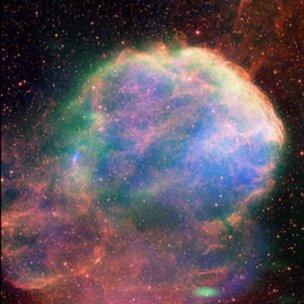Cosmic rays: Fermi telescope settles mystery of origin
- Published

The IC 433 supernova was a rich source of gamma rays
Scientists have conclusive proof that many cosmic rays raining down on Earth come from distant exploded stars.
Cosmic rays - mostly ultra-fast proton particles - would threaten life if not for the shielding of our planet's atmosphere and magnetic field.
Nasa's Fermi telescope was used to study the very distinctive light that is produced when these protons crash into other particles in space.
This allowed researchers to trace their source directly to ancient supernovas.
The study was led by Stefan Funk, external from Stanford University and the SLAC National Accelerator Laboratory, external.
His team has published its work in this week’s Science magazine. Dr Funk himself has also presented it here in Boston at the annual meeting of the American Association for the Advancement of Science, external.
Scientists have long suspected that many of the cosmic rays detected at Earth were accelerated in the colossal blasts that mark the demise of big stars, but the evidence has always carried some ambiguity.
Part of the reason is the protons’ positive charge. This means they get deflected by any magnetic field they encounter as they travel through space, making it impossible with complete confidence to track them back to the place they set off.
Dr Stefan Funk: ''They are not rays at all, they are particles''
"When they arrive at Earth, they arrive as we say isotropically - that is, with the same flux from all directions," Dr Funk told the BBC.
"So if we had cosmic ray eyes and were to look at the sky, it would be extremely boring because it would just be a plane that appears the same in every direction."
'Energy kick'
The Fermi telescope, external’s solution was to look for a characteristic light signature it could associate with known events.
In particular, it looked for a phenomenon known as pion decay.
Collisions between the cosmic rays and the slower-moving protons that exist in the gas and the dust around a supernova should produce subatomic particles called neutral pions.
The pions, in turn, will decay rapidly into very high-energy light, or gamma rays. These gamma rays are not affected by magnetic fields and will travel in straight lines until they fall on Fermi’s main instrument, its Large Area Telescope.
Dr Funk and his colleagues analysed Fermi’s observations of the debris left by two exploded stars named IC 433 and W44. Both lie within our galaxy - IC 443 is about 5,000 light-years from Earth; W44 is located about 10,000 light-years away.
Both these supernova remnants are strong sources of the type of gamma rays one would expect from neutral pion decay.
"The interesting thing is that the protons don't get accelerated in the supernova explosion itself, but they get accelerated in what we call the remnant - the shockwave that is created in the explosion and then moves away through the interstellar medium," said Dr Funk.
"The process by which the particles are accelerated in this shockwave is actually a slow one. The particles get a little kick in energy every time they cross the shock front, and eventually they get accelerated to these massive energies that we detect here at Earth.
"This acceleration process was first theorised by Enrico Fermi and therefore it is very fitting that the Fermi Gamma Ray Telescope has now found the evidence for it."
Dr Patrick Slane is from the Harvard-Smithsonian Center for Astrophysics in Cambridge, Massachusetts. He was not involved in the study but describes its findings as "incontrovertible evidence".
"It's a clear demonstration of the physical principles that we really thought were happening here; that we really have protons being accelerated to high energies with high efficiencies in these two supernova remnants, and by inference many other supernovas remnants that show similar signals are probably doing the same as well."
Exploded stars may account for most of the cosmic rays that are produced in our Milky Way Galaxy, but there is another class of cosmic rays at even higher energies and these are thought to have their origins further afield. One likely source for these is the powerful jets of energy seen sweeping out from some giant black holes.
These environments should also be able to accelerate protons to near light-speed.
Jonathan.Amos-INTERNET@bbc.co.uk and follow me on Twitter: @BBCAmos, external
- Published25 July 2012
- Published10 January 2013